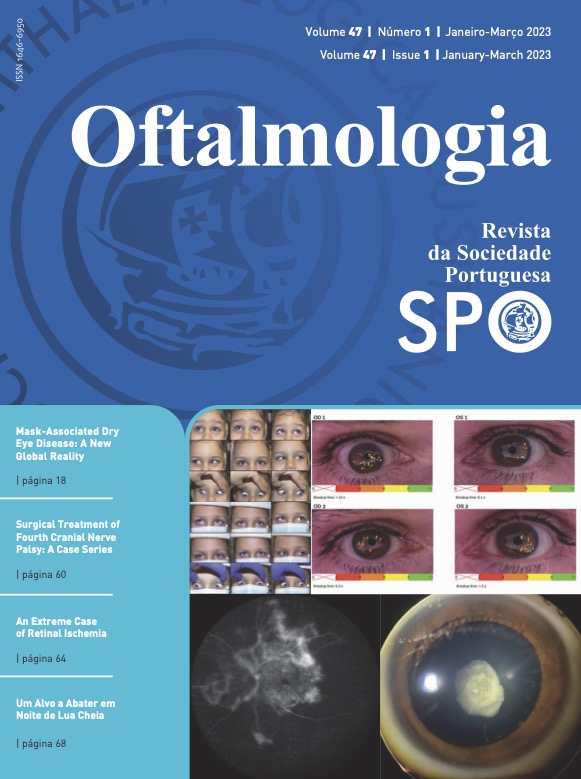Resultados Clínicos Iniciais do Dispositivo Preserflo Microshunt
DOI:
https://doi.org/10.48560/rspo.25962Palavras-chave:
Cirurgia Filtrante, Glaucoma/cirurgia, Implantes de Drenagem de Glaucoma, Pressão IntraocularResumo
INTRODUÇÃO : O objectivo deste estudo foi analisar a eficácia e perfil de segurança do Preserflo® Microshunt, um dispositivo de filtração subtenoniana ab externo aprovado para tratamento cirúrgico do glaucoma.
MÉTODOS: Estudo observacional retrospectivo. Foram incluídos doentes implantados com Preserflo® Microshunt isoladamente ou em combinação com facoemulsificação com um mínimo de 3 meses de seguimento. O outcome primário foi o sucesso cirúrgico definido como uma redução mínima de 30% da pressão intraocular (PIO) basal e uma PIO não medicada ≤18 mmHg. Outcomes secundários incluíram o número de medicações hipotensivas e efeitos adversos.
RESULTADOS: Foram incluídos 92 olhos de 77 doentes (idade média ± DP 68±18 anos), a maioria dos quais submetidos a cirurgia isolada (n=74 olhos; 80%). O tempo médio de seguimento pós-operatório foi de 9±6 meses, tendo mais de três quartos (n=70; 76%) completado pelo menos 6 meses de seguimento e um terço (n=30; 33%) com o mínimo de 12 meses. A PIO média foi signifi- cativamente reduzida em todos os pontos de análise face à PIO basal de 22±5,8 mmHg até 13,9±4,8 aos 12 meses (p<0,0001). O número médio de medicações hipotensivas desceu 2,8±0,9 para 0,5±0,9 na última observação (p<0,0001), com 75% dos olhos sem medicação durante todo o seguimento. O sucesso absoluto aos 12 meses foi de 46%, e 64% contando com medicação (qualificado). As complicações incluíram hemorragia angular intra-operatória ou hifema pós-operatório (n total=9; 10%), e câmara anterior baixa (n=4; 4%), com resolução espontânea. Não se registaram quaisquer complicações graves ou com necessidade de intervenção cirúrgica.
CONCLUSÃO: A análise inicial do Preserflo® Microshunt em contexto clínico sugere que é uma cirurgia segura e eficaz no tratamento do glaucoma não controlado medicamente.
Downloads
Referências
Tham YC, Li X, Wong TY, Quigley HA, Aung T, Cheng CY. Global prevalence of glaucoma and projections of glaucoma burden through 2040: A systematic review and meta-anal- ysis. Ophthalmology. 2014;121:2081-90. doi:10.1016/j.oph- tha.2014.05.013
Causes of blindness and vision impairment in 2020 and trends over 30 years, and prevalence of avoidable blindness in relation to VISION 2020: the Right to Sight: an analysis for the Global Burden of Disease Study. Lancet Glob Heal. 2021;9:e144-e160. doi:10.1016/S2214-109X(20)30489-7
Vinod K, Gedde SJ, Feuer WJ, Panarelli JF, Chang TC, Chen PP, et al. Practice Preferences for Glaucoma Surgery. J Glaucoma. 2017;26:687-693. doi:10.1097/IJG.0000000000000720
Rathi S, Andrews CA, Greenfield DS, Stein JD. Trends in Glaucoma Surgeries Performed by Glaucoma Subspecialists versus Nonsubspecialists on Medicare Beneficiaries from 2008 through 2016. Ophthalmology. 2021;128:30-8. doi:10.1016/j. ophtha.2020.06.051
Gedde SJ, Schiffman JC, Feuer WJ, Herndon LW, Brandt JD, Budenz DL. Treatment Outcomes in the Tube Versus Trabeculectomy (TVT) Study After Five Years of Follow-up. Am J Ophthalmol. 2012;153:789-803.e2. doi:10.1016/j.ajo.2011.10.026
Gedde SJ, Feuer WJ, Lim KS, Barton K, Goyal S, Ahmed IK, et al. Treatment Outcomes in the Primary Tube Versus Trabeculectomy Study after 3 Years of Follow-up. Ophthalmology. 2020;127:333-45. doi: 10.1016/j.ophtha.2019.10.002.
Chu C, Liebmann JM, Ciof GA, Blumberg DM, Al-aswad LA. Reoperations for Complications Within 90 Days After Glaucoma Surgery. J Glaucoma. 2020;29:344-6. doi:10.1097/ IJG.0000000000001484
Conlon R, Saheb H, Ahmed IIK. Glaucoma treatment trends: a review. Can J Ophthalmol. 2017;52:114-24. doi:10.1016/j. jcjo.2016.07.013
Coleman AL, Richter G. Minimally invasive glaucoma sur- gery: current status and future prospects. Clin Ophthalmol. 2016:189. doi:10.2147/OPTH.S80490
European Glaucoma Society. Terminology and Guidelines for Glaucoma. 5th ed. Amsterdam: Publicomm; 2020.
Pinchuk L, Riss I, Batlle JF, Kato YP, Martin JB, Arrieta E, et al. The use of poly(styrene-block-isobutyleneblock- styrene) as a microshunt to treat glaucoma. Regen Biomater. 2016;3:137-42. doi:10.1093/RB/RBW005
Batlle JF, Fantes F, Riss I, Pinchuk L, Alburquerque R, Kato YP, et al. Three-year follow-up of a novel aqueous humor microshunt. J Glaucoma. 2016;25:e58-e65. doi:10.1097/ IJG.0000000000000368
Shaarawy TM, Aptel F, Beckers HJ. 12-month interim results of a multicentre open-label study of the InnFocus MicroShunt® Glaucoma Drainage System in patients with primary open- angle glaucoma. Invest Ophthalmol Vis Sci. 2018;59:3457.
Fea AM, Laffi GL, Martini E, Economou MA, Caselgrandi P, Sacchi M, et al. Effectiveness of MicroShunt in Patients with Primary Open-Angle and Pseudoexfoliative Glaucoma: A Retrospective European Multicenter Study. Ophthalmol Glaucoma. 2022;5:210-8. doi: 10.1016/j.ogla.2021.08.005.
Schlenker MB, Durr GM, Michaelov E, Ahmed IK. Intermedi- ate Outcomes of a Novel Standalone Ab Externo SIBS Microshunt With Mitomycin C. Am J Ophthalmol. 2020;215:141-53. doi:10.1016/j.ajo.2020.02.020
Beckers HJ, Aptel F, Webers CA, Bluwol E, Martínez-de-la- Casa JM, García-Feijoó J, et al. Safety and Effectiveness of the PRESERFLO® MicroShunt in Primary Open-Angle Glaucoma: Results from a 2-Year Multicenter Study. Ophthalmol Glaucoma. 2022;5:195-209. doi: 10.1016/j.ogla.2021.07.008.
Martínez-de-la-Casa JM, Saenz-Francés F, Morales-Fernandez L, et al. Clinical outcomes of combined Preserflo Microshunt implantation and cataract surgery in open-angle glaucoma patients. Sci Rep. 2021;11:1-8. doi:10.1038/s41598-021-95217-x
Baker ND, Barnebey HS, Moster MR, Stiles MC, Vold SD, Khatana AK, et al. Ab-Externo MicroShunt versus Trabeculectomy in Primary Open-Angle Glaucoma: One-Year Results from a 2-Year Randomized, Multicenter Study. Ophthalmol- ogy. 2021;128:1710-21. doi: 10.1016/j.ophtha.2021.05.023.
Shaarawy TM, Sherwood MB, Grehn F, editors. Guidelines on Design and Reporting of Surgical Trials - World Glaucoma Association. Philadelphia: Kugler Publications; 209.
Pillunat KR, Herber R, Haase MA, Jamke M, Jasper CS, Pil- lunat LE. PRESERFLOTM MicroShunt versus trabeculecomy: first results on efficacy and safety. Acta Ophthalmol. 2022;100:e779-e790. doi: 10.1111/aos.14968.
Gizzi C, Costa G, Servadei R, Abed E, Ning B, Sharma A, et al. A case of malignant glaucoma following insertion of PreserfloTM MicroShunt. Eur J Ophthalmol. 2022;32:NP115-9. doi: 10.1177/11206721211003492.
Micheletti E, Riva I, Bruttini C, Quaranta L. A Case of Delayed- onset Hemorrhagic Choroidal Detachment after PreserFlo Microshunt Implantation in a Glaucoma Patient under Anti- coagulant Therapy. J Glaucoma. 2020;29:E87-E90. doi:10.1097/ IJG.0000000000001584
Agrawal P, Bradshaw SE. Systematic Literature Review of Clinical and Economic Outcomes of Micro-Invasive Glaucoma Surgery ( MIGS ) in Primary Open-Angle Glaucoma. Ophthalmol Ther. 2018;7:49-73. doi:10.1007/s40123-018-0131-0 Derick RJ, Evans J, Baker ND. Combined phacoemulsification and trabeculectomy versus trabeculectomy alone: a com- parison study using mitomycin-C. Ophthalmic Surg Lasers. 1998;29:707-13.
Marcos Parra MT, Salinas López JA, López Grau NS, Ceaus- escu AM, Pérez Santonja JJ. XEN implant device versus trabeculectomy, either alone or in combination with phacoemulsi- fication, in open-angle glaucoma patients. Graefe’s Arch Clin Exp Ophthalmol. 2019;257:1741-50. doi: 10.1007/s00417-019- 04341-y.
Siriwardena D, Kotecha A, Minassian D, Dart JK, Khaw PT. Anterior chamber flare after trabeculectomy and after phacoemulsification. Br J Ophthalmol. 2000;84:1056-7. doi:10.1136/ bjo.84.9.1056
Kerr NM, Ahmed IIK, Pinchuk L, Sadruddin O, Palmberg PF. PRESERFLO MicroShunt. In: Minimally Invasive Glaucoma Surgery. Berlin: Springer; 2021. p.91-103.
Kirwan JF, Lockwood AJ, Shah P, et al. Trabeculectomy in the 21st century: A multicenter analysis. Ophthalmology. 2013;120:2532-9. doi:10.1016/j.ophtha.2013.07.049
Downloads
Publicado
Como Citar
Edição
Secção
Licença
Direitos de Autor (c) 2023 Revista Sociedade Portuguesa de Oftalmologia

Este trabalho encontra-se publicado com a Creative Commons Atribuição-NãoComercial 4.0.
Não se esqueça de fazer o download do ficheiro da Declaração de Responsabilidade Autoral e Autorização para Publicação e de Conflito de Interesses
O artigo apenas poderá ser submetido com esse dois documentos.
Para obter o ficheiro da Declaração de Responsabilidade Autoral, clique aqui
Para obter o ficheiro de Conflito de Interesses, clique aqui





